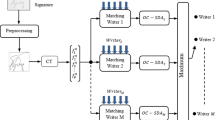Abstract
Nowadays with the development of photosensitive seal technology, the seal fraud events have gradually increased. Forged seals can bring considerable benefits to counterfeiters, and will also bring huge losses to companies and users. Since it is almost impossible to collect enough forged seal samples, traditional machine learning methods do not work in this situation. In this paper, a method based on PU learning and distance learning is proposed. This method uses a limited number of labeled samples and some unlabeled samples to train multiple kNN classifiers to identify forged seal imprints, and use distance learning to improve the performance of kNN classifiers. The experimental results show that the F1-score of the proposed method can reach 0.97 regardless of the seal imprints with lots of text background noise, which outweighs many traditional models.







Similar content being viewed by others

References
Basile T, Mauro N, Esposito F, Ferilli S, Vergari A (2019) Ensembles of density estimators for positive-unlabeled learning. J Intell Inf Syst 53(2):199–217. https://doi.org/10.1007/s10844-019-00549-w
Bekker J, Davis J (2018) Learning from positive and unlabeled data: a survey. Mach Learn 109:719–760
Chen YS (1996) Automatic identification for a Chinese seal image. Pattern Recogn 29(11):1807–1820. https://doi.org/10.1016/0031-3203(96)00032-5
Chen X, Zhong H, Bao Z (2019) A GLCM-feature-based approach for reversible image transformation. Comp Mater Cont 59(1):239–255. https://doi.org/10.32604/cmc.2019.03572
Claesen M, Smet FD, Suykens J, Moor BD (2015) A robust ensemble approach to learn from positive and unlabeled data using SVM base models. Neurocomputing 160:73–84. https://doi.org/10.1016/j.neucom.2014.10.081
Elkan, Noto K (2018) Learning classifiers from only positive and unlabeled data. In: Proceedings of ACM SIGKDD International Conference on Knowledge Discovery and Data Mining(KDD-2008). https://doi.org/10.1145/1401890.1401920
Gan H, Zhang Y, Song Q (2019) Bayesian belief network for positive unlabeled learning with uncertainty. Pattern Recogn Lett 90:28–35. https://doi.org/10.1016/j.patrec.2017.03.007
Gong C, Liu T, Yang J, Tao D (2019) Large-margin label-calibrated support vector Machines for Positive and Unlabeled Learning. IEEE Transact Neur Netw Learn Syst 30:1396–1409. https://doi.org/10.1109/TNNLS.2019.2892403
Gong C, Shi H, Yang J, Yang J (2019) Multi-manifold positive and unlabeled learning for visual analysis. IEEE Transact Circ Syst Vid Technol 30:3471–3483. https://doi.org/10.1109/TCSVT.2019.2903563
Ju H, Lee D, Hwang J, Namkung J, Yu H (2020) PUMAD: PU metric learning for anomaly detection. Inf Sci 523:167–183. https://doi.org/10.1016/j.ins.2020.03.021
Kwon Y, Kim W, Sugiyama M, Paik MC (2020) Principled analytic classifier for positive-unlabeled learning via weighted integral probability metric. Mach Learn 109(20):513–532. https://doi.org/10.1007/s10994-019-05836-9
Lee WS, Liu B (2003) Learning with positive and unlabeled samples using weighted logistic regression. In: ICML, vol 3, pp. 448–455
Li D (2010) Color seal segmentation and identification. Technological Developments in Networking, Education and Automation, pp. 333–334. https://doi.org/10.1007/978-90-481-9151-2_58
Li C , Hua X L (2019) Towards positive unlabeled learning for parallel data mining: a random Forest framework. In: The 10th International Conference on Advanced Data Mining and Applications, pp 573-587. https://doi.org/10.1007/978-3-319-14717-8_45
Liu B, Dai Y, Li X et al (2003) Building text classifiers using positive and unlabeled samples. In: proceedings of the 3rd IEEE international conference on data mining, pp 179–188. https://doi.org/10.1109/ICDM.2003.1250918
Run L, Zhi F, Sheng W, Shou Y. (2007) Feature extraction of seal imprint based on the double-density dual-tree DWT. Lect Notes Comp Sci 4488. https://doi.org/10.1007/978-3-540-72586-2_146
Sakai T, Plessis M, Niu G, Sugiyama M (2017) Semi-supervised classification based on classification from positive and unlabeled data. In: Proceedings of the 34th International Conference on Machine Learning, vol. 70, pp 2998-3006
Su YC, Ueng YL, Chung WH (2019) SVM-based seal imprint verification using edge difference. IEEE Access PP(99):1-1. https://doi.org/10.1109/ACCESS.2019.2945045
Wang X, Chen Y (2011) A novel seal imprint verification method based on analysis of difference images and symbolic representation. Lect Notes Comput Sci 6540:56–67. https://doi.org/10.1007/978-3-642-19376-7_5
Wang Q, Luo Z, Huang J, Feng Y (2017) Liu Z (2017) a novel ensemble method for imbalanced data learning: bagging of extrapolation-SMOTE SVM. Comput Intell Neurosci 2017(3):1827016–1827011. https://doi.org/10.1155/2017/1827016
Weinberger KQ, Saul LK (2009) Distance metric learning for large margin nearest neighbor classification. J Mach Learn Res 10(1):207–244
Wu Q, Li Y, Lin Y, Zhou R (2018) Weighted sparse image classification based on low rank representation. Comp Mater Cont 56(1):91–105. https://doi.org/10.3970/cmc.2018.02771
Wu Z, Cao J, Wang Y, Wang Y, Zhang L, Wu J (2018) hPSD: a hybrid PU-learning-based spammer detection model for product reviews. IEEE Transact Cybernet 50:1595–1606. https://doi.org/10.1109/TCYB.2018.2877161
Zhang H, He J (2010) Automatic seal imprint verification by quantifying edge difference. Optoelectron Imaging Multimed Technol 7850:78500D. https://doi.org/10.1117/12.870202
Zheng L, Song C (2018) Fast near-duplicate image detection in Riemannian space by a novel hashing scheme. Comp Mater Cont 56(3):529–539. https://doi.org/10.1145/2602186
Acknowledgements
This work is supported by the NSFC [grant numbers 61772281, 61703212], the Priority Academic Program Development of Jiangsu Higher Education Institutions (PAPD) and Jiangsu Collaborative Innovation Center on Atmospheric Environment and Equipment Technology (CICAEET).
Author information
Authors and Affiliations
Corresponding author
Additional information
Publisher’s note
Springer Nature remains neutral with regard to jurisdictional claims in published maps and institutional affiliations.
Rights and permissions
About this article
Cite this article
Yan, L., Chen, K., Tong, S. et al. Identifying forged seal imprints using positive and unlabeled learning. Multimed Tools Appl 80, 30761–30773 (2021). https://doi.org/10.1007/s11042-020-10171-6
Received:
Revised:
Accepted:
Published:
Issue Date:
DOI: https://doi.org/10.1007/s11042-020-10171-6



